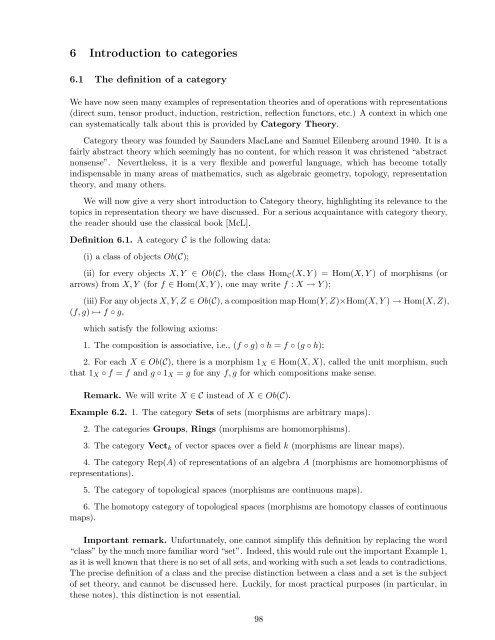Lecture notes for Introduction to Representation Theory
Lecture notes for Introduction to Representation Theory
Lecture notes for Introduction to Representation Theory
Create successful ePaper yourself
Turn your PDF publications into a flip-book with our unique Google optimized e-Paper software.
6 <strong>Introduction</strong> <strong>to</strong> categories<br />
6.1 The definition of a category<br />
We have now seen many examples of representation theories and of operations with representations<br />
(direct sum, tensor product, induction, restriction, reflection func<strong>to</strong>rs, etc.) A context in which one<br />
can systematically talk about this is provided by Category <strong>Theory</strong>.<br />
Category theory was founded by Saunders MacLane and Samuel Eilenberg around 1940. It is a<br />
fairly abstract theory which seemingly has no content, <strong>for</strong> which reason it was christened “abstract<br />
nonsense”. Nevertheless, it is a very flexible and powerful language, which has become <strong>to</strong>tally<br />
indispensable in many areas of mathematics, such as algebraic geometry, <strong>to</strong>pology, representation<br />
theory, and many others.<br />
We will now give a very short introduction <strong>to</strong> Category theory, highlighting its relevance <strong>to</strong> the<br />
<strong>to</strong>pics in representation theory we have discussed. For a serious acquaintance with category theory,<br />
the reader should use the classical book [McL].<br />
Definition 6.1. A category C is the following data:<br />
(i) a class of objects Ob(C);<br />
(ii) <strong>for</strong> every objects X, Y Ob(C), the class Hom C (X, Y ) = Hom(X, Y ) of morphisms (or<br />
arrows) from X, Y (<strong>for</strong> f Hom(X, Y ), one may write f : X ⊃ Y );<br />
(iii) For any objects X, Y, Z Ob(C), a composition map Hom(Y, Z)×Hom(X, Y ) ⊃ Hom(X, Z),<br />
(f, g) ⊃ f ∞ g,<br />
which satisfy the following axioms:<br />
1. The composition is associative, i.e., (f ∞ g) ∞ h = f ∞ (g ∞ h);<br />
2. For each X Ob(C), there is a morphism 1 X Hom(X, X), called the unit morphism, such<br />
that 1 X ∞ f = f and g ∞ 1 X = g <strong>for</strong> any f, g <strong>for</strong> which compositions make sense.<br />
Remark. We will write X C instead of X Ob(C).<br />
Example 6.2. 1. The category Sets of sets (morphisms are arbitrary maps).<br />
2. The categories Groups, Rings (morphisms are homomorphisms).<br />
3. The category Vect k of vec<strong>to</strong>r spaces over a field k (morphisms are linear maps).<br />
4. The category Rep(A) of representations of an algebra A (morphisms are homomorphisms of<br />
representations).<br />
5. The category of <strong>to</strong>pological spaces (morphisms are continuous maps).<br />
6. The homo<strong>to</strong>py category of <strong>to</strong>pological spaces (morphisms are homo<strong>to</strong>py classes of continuous<br />
maps).<br />
Important remark. Un<strong>for</strong>tunately, one cannot simplify this definition by replacing the word<br />
“class” by the much more familiar word “set”. Indeed, this would rule out the important Example 1,<br />
as it is well known that there is no set of all sets, and working with such a set leads <strong>to</strong> contradictions.<br />
The precise definition of a class and the precise distinction between a class and a set is the subject<br />
of set theory, and cannot be discussed here. Luckily, <strong>for</strong> most practical purposes (in particular, in<br />
these <strong>notes</strong>), this distinction is not essential.<br />
98

















